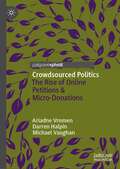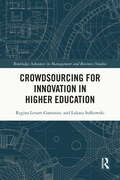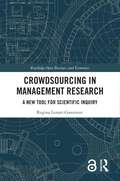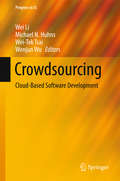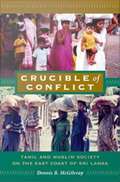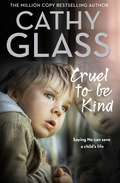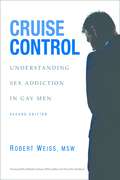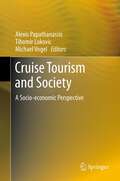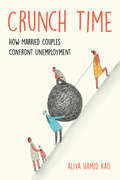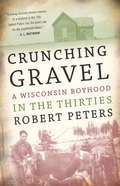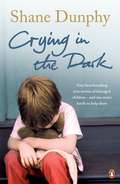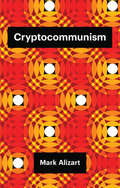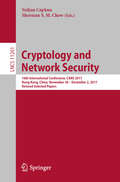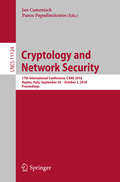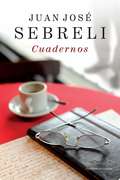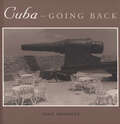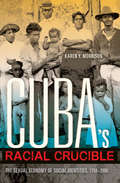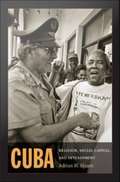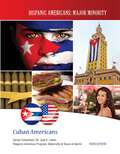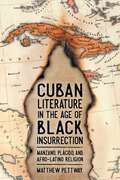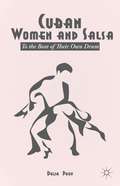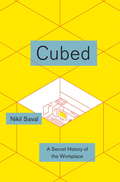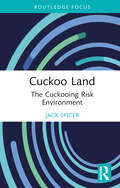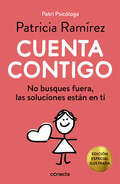- Table View
- List View
Crowdsourced Politics: The Rise of Online Petitions & Micro-Donations
by Darren Halpin Ariadne Vromen Michael VaughanThis book focuses on online petitioning and crowdfunding platforms to demonstrate the everyday impact that digital communications have had on contemporary citizen participation. In doing do, the book argues that crowdsourced participation has become normalised and institutionalised into the everyday repertoires of citizens and their organisations. Within the digitally-enabled shift in individual acts of participation, creating, signing and sharing online petitions and micro-donations have become a focal point because of the clear evolution from their offline and online counterparts.To illustrate their arguments the authors use an original nationally representative survey on acts of political engagement, undertaken with Australian citizens. Additionally, through detailed interviews and analysis of their web presence they show how advocacy organisations use online petitions within their repertoire of strategic actions. Lastly, they analyse the kinds of policy issues that mobilise citizens on crowdsourcing platforms, based on a unique dataset of 17,000 petitions from the popular non-government platform, Change.org. They contrast these mass public concerns with the policy agenda of the government of the day to show there is a disjuncture and general lack of responsiveness to this form of citizen expression.
Crowdsourcing for Innovation in Higher Education (Routledge Advances in Management and Business Studies)
by Łukasz Sułkowski Regina Lenart-GansiniecSignificant disruption to the educational sector occurred due to the COVID-19 pandemic. This shed a light on the need for new delivery methods and greater collaboration, which has become urgent and obvious as existing structures and traditional channels have struggled to cope or shut down. Higher education institutions often fail to crowdsource successfully because crowds differ in how they are organized compared to traditional sourcing. Instead of managing, higher education institutions work with external contributors who self-select into the process. Crowdsourcing has significant potential to transform the education space by enhancing existing methodologies and offering innovative possibilities to develop new pedagogical techniques. This offers benefits for practitioners, institutions, students and participants. Drawing on theory and best practice, illustrated with a wide range of the examples and cases, Crowdsourcing for Innovation in Higher Education offers invaluable guidance and will be of interest to researchers, academics, policymakers, and students in the fields of higher education, development studies, organizational studies, management science, and knowledge management.
Crowdsourcing in Management Research: A New Tool for Scientific Inquiry (Routledge Open Business and Economics)
by Regina Lenart-GansiniecCrowdsourcing in Management Research explores the evolving landscape of academic research in the context of contemporary legal, social, cultural, and technological shifts. The book delves into the intricate processes and challenges associated with managing crowdsourcing initiatives in science. It sheds light on the essential competencies required by those initiating crowdsourcing projects, offering practical insights for effective implementation. Furthermore, the text explores the future directions of crowdsourcing in science, considering the influence of emerging technologies such as blockchain, digital storytelling, gamification, metaverse, augmented reality, and artificial intelligence. As one of the few comprehensive resources available, the book serves as a valuable guide for scholars, researchers, and graduate students interested in crowdsourcing paradigms. It emphasizes accessibility by avoiding unnecessary jargon and caters to non‑specialist readers, including booksellers and librarians. The geographical and temporal relevance of the work is underlined, providing a contemporary perspective on the subject. The inclusion of well‑known and topical case studies enhances the book’s relevance, while groundbreaking content ensures its significance in the rapidly evolving field of management research.
Crowdsourcing: Cloud-Based Software Development (Progress in IS)
by Wei Li Michael N. Huhns Wei-Tek Tsai Wenjun WuThis book presents the latest research on the software crowdsourcing approach to develop large and complex software in a cloud-based platform. It develops the fundamental principles, management organization and processes, and a cloud-based infrastructure to support this new software development approach. The book examines a variety of issues in software crowdsourcing processes, including software quality, costs, diversity of solutions, and the competitive nature of crowdsourcing processes. Furthermore, the book outlines a research roadmap of this emerging field, including all the key technology and management issues for the foreseeable future. Crowdsourcing, as demonstrated by Wikipedia and Facebook for online web applications, has shown promising results for a variety of applications, including healthcare, business, gold mining exploration, education, and software development. Software crowdsourcing is emerging as a promising solution to designing, developing and maintaining software. Preliminary software crowdsourcing practices and platforms, including Apple's App Store and TopCoder, demonstrate the advantages of crowdsourcing in terms of software ecosystem expansion and product quality improvement.
Crown: An Ode to the Fresh Cut (Denene Millner Books)
by Derrick Barnes Gordon C. JamesThe barbershop is where the magic happens. Boys go in as lumps of clay and, with princely robes draped around their shoulders, a dab of cool shaving cream on their foreheads, and a slow, steady cut, they become royalty. That crisp yet subtle line makes boys sharper, more visible, more aware of every great thing that could happen to them when they look good: lesser grades turn into As; girls take notice; even a mother’s hug gets a little tighter. Everyone notices. <P><P>A fresh cut makes boys fly. <P><P>This rhythmic, read-aloud title is an unbridled celebration of the self-esteem, confidence, and swagger boys feel when they leave the barber’s chair—a tradition that places on their heads a figurative crown, beaming with jewels, that confirms their brilliance and worth and helps them not only love and accept themselves but also take a giant step toward caring how they present themselves to the world. The fresh cuts. That’s where it all begins. <P><P>Crown: An Ode to the Fresh Cut is a high-spirited, engaging salute to the beautiful, raw, assured humanity of black boys and how they see themselves when they approve of their reflections in the mirror.
Crucible of Conflict: Tamil and Muslim Society on the East Coast of Sri Lanka
by Dennis B. McgilvrayCrucible of Conflict is an ethnographic and historical study of Hindu castes, matrilineal family structure, popular religious traditions, and ethnic conflict. It is also the first full-length ethnography of Sri Lanka's east coast, an area that suffered heavily in the 2004 tsunami and that is of vital significance to the political future of the island nation. Since the bitter guerrilla war for an independent Tamil homeland in Sri Lanka broke out in 1983, the easternmost region of the island has emerged as a strategic site of conflict. Dennis B. McGilvray argues that any long-term resolution of the ethnic conflict must accommodate this region, in which Sinhalese Buddhists, Tamil Hindus, and Tamil-speaking Muslims are each a significant share of the population. McGilvray explores the densely populated farming and fishing settlements in this coastal zone, focusing on the Tamil and Muslim inhabitants of an agricultural town in the Ampara District. Drawing on fieldwork conducted over more than thirty years as well as on Tamil and Dutch historical sources, he describes the regional dominance of a non-Brahmin matrilineal caste of thirteenth-century Kerala origin. The Muslims, who acquired dowry lands and matrilineal family patterns through local intermarriages, have in the twentieth century emerged from Hindu caste domination and are now the Tamil Hindus' political and economic equals. Crucible of Conflict offers a uniquely detailed account of Muslim kinship and community organization in eastern Sri Lanka, as well as a comparison of Tamil and Muslim practices and institutions. McGilvray concludes with an analysis of the interethnic tensions and communal violence that have intensified in recent years.
Cruel To Be Kind
by Cathy GlassCruel To Be Kind is the true story of Max, aged 6. He is fostered by Cathy while his mother is in hospital with complications from type 2 diabetes. Cruel To Be Kind is the true story of Max, aged 6. He is fostered by Cathy while his mother is in hospital with complications from type 2 diabetes. Fostering Max gets off to a bad start when his mother, Caz, complains and threatens Cathy even before Max has moved in. Cathy and her family are shocked when they first meet Max. But his social worker isn't the only one in denial; his whole family are too.
Cruise Control: Understanding Sex Addiction In Gay Men Second Edition
by Robert WeissThe truth is gay male sex addicts are not compulsively sexual because of their sexual orientation, but rather as a consequence of their individual psychological issues and biological predisposition toward addiction. This is exactly the same set of risk factors presented by straight male sex addicts. Unfortunately, for the gay (sex) addict, his increasingly destructive patterns of behavior take place against a cultural background of dramatically greater sexual and social freedoms than those enjoyed by his heterosexual peers. The single urban gay man who has problems with sex, alcohol, or drugs is in some ways a prisoner of his own freedoms, having fewer cultural opportunities for self-examination and less cultural support for behavior change than does an average heterosexual male. Finally, there is a resource that can help gay men determine if they are indeed a sex addict and whether or not they are willing to explore behavior change because of their sexual behavior. Robert Weiss, LCSW, CSAT-S, is director of sexual disorders services for Elements Behavioral Health and founding director of The Sexual Recovery Institute, an outpatient sexual addiction treatment center in Los Angeles, California. His media appearances include ESPN, The Discovery Channel, the Today show,The Oprah Winfrey Show, Anderson Cooper, and Dateline NBC.
Cruise Tourism and Society: A Socio-economic Perspective
by Tihomir Lukovic Michael Vogel Alexis PapathanassisThe growth and increased popularity of cruises is accompanied by a number of sustainability issues concerning the environment, the port economies and societies; on board and at shore. The sustainability imperative ultimately leads to operational, economical as well as image-related challenges for the sector's decision-makers and stakeholders. This collection of peer-reviewed papers, presented during the 3rd International Cruise Conference (Dubrovnik, Croatia), seeks to address those issues and contribute to their management in the mid-term.
Crunch Time: How Married Couples Confront Unemployment
by Aliya Hamid RaoIn Crunch Time, Aliya Hamid Rao gets up close and personal with college-educated, unemployed men, women, and spouses to explain how comparable men and women have starkly different experiences of unemployment. Traditionally gendered understandings of work—that it’s a requirement for men and optional for women—loom large in this process, even for marriages that had been not organized in gender-traditional ways. These beliefs serve to make men’s unemployment an urgent problem, while women’s unemployment—cocooned within a narrative of staying at home—is almost a non-issue. Crunch Time reveals the minutiae of how gendered norms and behaviors are actively maintained by spouses at a time when they could be dismantled, and how gender is central to the ways couples react to and make sense of unemployment.
Crunching Gravel: A Wisconsin Boyhood in the Thirties
by Robert PetersNo nostalgic tale of the good old days, Robert Peters’s recollections of his adolescence vividly evoke the Depression on a hardscrabble farm near Eagle River: Dad driving the Vilas County Relief truck, Lars the Swede freezing to death on his porch, the embarassment of graduation in a suit from welfare. The hard efforts to put fish and potatoes and blueberries on the table are punctuated by occasional pleasures: the Memorial Day celebration, swimming at Perch Lake, the county fair with Mother’s prizes for jam and the exotic delights of the midway. Peters’s clear-eyed memoir reveals a poet’s eye for rich and stark detail even as a boy of twelve. “Peters misses nothing, from the details of the town’s Fourth of July celebration to the cause and effect of a young cousin’s suicide to the calibrations of racism toward Indians that was so acceptable then. It is a fascinating, unsentimental look at a piece of our past. ”—Margaret E. Guthrie,New York Times Book Review “It’s unlikely that any other contemporary poet and scholar as distinguished has risen from quite so humble beginnings as Robert Peters. Born and raised by semiliterate parents on a subsistence farm in northeastern Wisconsin, Peters lived harrowingly close to the eventual stuff of his poetry—the dependency of humans on animal lives, the inexplicable and ordinary heroism and baseness of people facing extreme conditions, the urgency of physical desire. . . . Sterling childhood memoirs. ”—Booklist “Robert Peters has written a memoir exemplary because he insists on the specific, on the personal and the local. It is also enormously satisfying to read, and it is among the most authentic accounts of childhood and youth I know—a Wisconsin David Copperfield!”—Thom Gunn
Crying in the Dark
by Shane DunphyFour extraordinary true stories ... Bobby and Micky, six and four, controlled from beyond the grave by their evil father ... Mina, seventeen, who has Downs Syndrome, desperate to be like everyone else, falling into the hands of men who abuse her trust ... Sylvie, a fourteen-year-old mother being pimped by her father ... Twins Larry and Francey, ten, scarcely human after an upbringing of savage and unimaginable cruelty ... One inspiring account of how one man got to know these wounded children and tried to give them hope - and a future.
Cryptocommunism (Theory Redux)
by Mark AlizartCryptocurrencies are often associated with right-wing political movements, or even with the alt-right. They are the preserve of libertarians and fans of Ayn Rand and Friedrich Hayek. With their promotion of anonymity and individualism, there’s no doubt that they seamlessly slot into the prevailing anti-State ideology. But in this book Mark Alizart argues that the significance of cryptocurrencies goes well beyond cryptoanarchism. In so far as they allow us ‘to appropriate collectively the means of monetary production’, to paraphrase Marx, and to replace ‘the government of persons by the administration of things’, as Engels advocated, they form the basis for a political regime that begins to look like a communism which has at last come to fruition – a cryptocommunism.
Cryptology and Network Security: 16th International Conference, CANS 2017, Hong Kong, China, November 30—December 2, 2017, Revised Selected Papers (Lecture Notes in Computer Science #11261)
by Srdjan Capkun Sherman S. ChowThis book contains revised versions of all the papers presented at the 16th International Conference on Cryptology and Network Security, CANS 2017, held in Hong Kong, China, in November/ December 2017. The 20 full papers presented together with 8 short papers were carefully reviewed and selected from 88 submissions. The full papers are organized in the following topical sections: foundation of applied cryptography; processing encrypted data; predicate encryption; credentials and authentication; web security; Bitcoin and blockchain; embedded system security; anonymous and virtual private networks; and wireless and physical layer security.
Cryptology and Network Security: 17th International Conference, CANS 2018, Naples, Italy, September 30 – October 3, 2018, Proceedings (Lecture Notes in Computer Science #11124)
by Jan Camenisch Panos PapadimitratosThis book constitutes the refereed proceedings of the 17th International Conference on Cryptology and Network Security, CANS 2018, held in Naples, Italy, in September/October 2018. The 26 full papers were carefully reviewed and selected from 79 submissions. The papers are organized in the following topical sections: privacy; Internet misbehavior and protection; malware; symmetric key cryptography; signatures; cryptanalysis; cryptographic primitives; and cryptographic protocols.
Cuadernos
by Juan José SebreliSebreli rescata un género poco habitual en la literatura argentina: elcuaderno de notas de un escritor. En él reúne microsociología de lostemas más diversos. Con lucidez y osadía consigna singularidades y excepciones,pinta personajes extraños de conductas extremas, reconstruye lugaresinsólitos, devela ceremonias sociales, descifra mitos, evoca épocaspasadas, recupera «a la manera proustiana» escenas olvidadas y cuentaanécdotas que nunca son superficiales ni gratuitas: historias enapariencia banales pero sociológicamente significativas.El libro agrega a las cualidades características del autor como analistade lo cotidiano otros rasgos inéditos: su extraordinario sentido delhumor, por ejemplo, condición que permite, entre otras, una lecturahedónica y lúdica, muy por encima de lo meramente explicativo oinformativo.
Cuba -- Going Back
by Tony MendozaImagine being unable to return to your homeland for thirty-six years. What would you do if you finally got a chance to go back? In 1996, after travel restrictions between the United States and Cuba were relaxed, Cuban exile Tony Mendoza answered that question. Taking his cameras, notebooks, and an unquenchable curiosity, he returned for his first visit to Cuba since the summer of 1960, when he emigrated with his family at age eighteen. In this book he presents over eighty evocative photographs accompanied by a beautifully written text that mingles the voices of many Cubans with his own to offer a compelling portrait of a resilient people awaiting the inevitable passing of the socialist system that has failed them. His photographs and interviews bear striking witness to the hardships and inequalities that exist in this workers#146; "paradise," where the daily struggle to make ends meet on an average income of eight dollars a month has created a longing for change even in formerly ardent revolutionaries. At the same time, Cuba#151;Going Back is an eloquent record of a personal journey back in time and memory that will resonate with viewers and readers both within and beyond the Cuban American community. It belongs on the shelves of anyone who values excellent photography and well-crafted prose.
Cuba's Racial Crucible: The Sexual Economy of Social Identities, 1750–2000 (Blacks in the Diaspora)
by Karen Y. MorrisonThis prize-winning study examines the historical interplay of racial identity, nationality, and family formation in Cuba from the 18th century to today.Since the 19th century, there have been two opposing perspectives on Cuban racial identity: one that frames Cubans as white, and one that sees them as racially mixed based on acceptance of African descent. For the past two centuries, these competing views of have remained in continuous tension, while Cuban women and men make their own racially oriented decisions about choosing partners and family formation.Cuba&’s Racial Crucible explores the historical dynamics of Cuban race relations by highlighting the role race has played in reproductive practices and genealogical memories associated with family formation. Karen Y. Morrison reads archival, oral-history, and literary sources to demonstrate the ideological centrality and inseparability of "race," "nation," and "family," in definitions of Cuban identity. Morrison also analyzes the conditions that supported the social advance and decline of notions of white racial superiority, nationalist projections of racial hybridity, and pride in African descent.Winner, NECLAS Marissa Navarro Best Book Prize
Cuba: Religion, Social Capital, and Development
by Adrian H. HearnWhen Cuba's centralized system for providing basic social services began to erode in the early 1990s, Christian and Afro-Cuban religious groups took on new social and political responsibilities. They began to work openly with state institutions on projects such as the promotion of Afro-Cuban heritage to encourage tourism, and community welfare initiatives to confront drug use, prostitution, and housing decay. In this rich ethnography, the anthropologist Adrian H. Hearn provides a detailed, on-the-ground analysis of how the Cuban state and local religious groups collaborate on community development projects and work with the many foreign development agencies operating in Cuba. Hearn argues that the growing number of collaborations between state and non-state actors has begun to consolidate the foundations of a civil society in Cuba. While conducting research, Hearn lived for one year each in two Santera temple-houses: one located in Old Havana and the other in Santiago de Cuba. During those stays he conducted numerous interviews: with the historian of Havana and the conservationist of Santiago de Cuba (officials roughly equivalent to mayors in the United States), acclaimed writers, influential leaders of Afro-Cuban religions, and many citizens involved in community development initiatives. Hearn draws on those interviews, his participant observation in the temple-houses, case studies, and archival research to convey the daily life experiences and motivations of religious practitioners, development workers, and politicians. Using the concept of social capital, he explains the state's desire to incorporate tightly knit religious groups into its community development projects, and he illuminates a fundamental challenge facing Cuba's religious communities: how to maintain their spiritual integrity and internal solidarity while participating in state-directed projects.
Cuban Americans (Hispanic Americans: Major Minority)
by Frank DepietroIn the United States, people from all different backgrounds live together. More than one in eight people in the United States are Hispanic--but they come from different lands and backgrounds. Many Latino Americans can trace their roots to the island of Cuba. In the second half of the twentieth century, Cubans poured into the United States, and today there are more than one million Cuban Americans. They have built successful communities, families, and businesses--and kept their own culture alive at the same time. Unfortunately, Cuban Americans have also run into hardship and prejudice. Discover Cuban Americans' struggles and their triumphs. Learn about the events that drove so many Cubans to America's shores. Find out how Cuban Americans make America stronger.
Cuban Literature in the Age of Black Insurrection: Manzano, Plácido, and Afro-Latino Religion (Caribbean Studies Series)
by Matthew PettwayJuan Francisco Manzano and Gabriel de la Concepción Valdés (Plácido) were perhaps the most important and innovative Cuban writers of African descent during the Spanish colonial era. Both nineteenth-century authors used Catholicism as a symbolic language for African-inspired spirituality. Likewise, Plácido and Manzano subverted the popular imagery of neoclassicism and Romanticism in order to envision black freedom in the tradition of the Haitian Revolution. Plácido and Manzano envisioned emancipation through the lens of African spirituality, a transformative moment in the history of Cuban letters. Matthew Pettway examines how the portrayal of African ideas of spirit and cosmos in otherwise conventional texts recur throughout early Cuban literature and became the basis for Manzano and Plácido’s antislavery philosophy. The portrayal of African-Atlantic religious ideas spurned the elite rationale that literature ought to be a barometer of highbrow cultural progress. Cuban debates about freedom and selfhood were never the exclusive domain of the white Creole elite. Pettway’s emphasis on African-inspired spirituality as a source of knowledge and a means to sacred authority for black Cuban writers deepens our understanding of Manzano and Plácido not as mere imitators but as aesthetic and political pioneers. As Pettway suggests, black Latin American authors did not abandon their African religious heritage to assimilate wholesale to the Catholic Church. By recognizing the wisdom of African ancestors, they procured power in the struggle for black liberation.
Cuban Women and Salsa
by Delia PoeySalsa is both an American and transnational phenomenon, however women in salsa have been neglected. To explore how female singers negotiate issues of gender, race, and nation through their performances, Poey engages with the ways they problematize the idea of the nation and facilitate their musical performances' movement across multiple borders.
Cubed: A Secret History of the Workplace
by Nikil SavalYou mean this place we go to five days a week has a history? Cubed reveals the unexplored yet surprising story of the places where most of the world's work—our work—gets done. From "Bartleby the Scrivener" to The Office, from the steno pool to the open-plan cubicle farm, Cubed is a fascinating, often funny, and sometimes disturbing anatomy of the white-collar world and how it came to be the way it is—and what it might become.<P> In the mid-nineteenth century clerks worked in small, dank spaces called “counting-houses.” These were all-male enclaves, where work was just paperwork. Most Americans considered clerks to be questionable dandies, who didn’t do “real work.” But the joke was on them: as the great historical shifts from agricultural to industrial economies took place, and then from industrial to information economies, the organization of the workplace evolved along with them—and the clerks took over. Offices became rationalized, designed for both greater efficiency in the accomplishments of clerical work and the enhancement of worker productivity. Women entered the office by the millions, and revolutionized the social world from within. Skyscrapers filled with office space came to tower over cities everywhere. Cubed opens our eyes to what is a truly "secret history" of changes so obvious and ubiquitous that we've hardly noticed them. From the wood-paneled executive suite to the advent of the cubicles where 60% of Americans now work (and 93% of them dislike it) to a not-too-distant future where we might work anywhere at any time (and perhaps all the time), Cubed excavates from popular books, movies, comic strips (Dilbert!), and a vast amount of management literature and business history, the reasons why our workplaces are the way they are—and how they might be better.
Cuckoo Land: The Cuckooing Risk Environment (Drugs, Crime and Society)
by Jack SpicerDrawing on rich qualitative data, this book presents a novel way of understanding the drug market-related harm of ‘cuckooing’, providing a theoretically informed account of this increasingly high-profile area.Applying the framework of the ‘risk environment’, the book examines why people become cuckooed, how it is responded to and how this exploitative practice is socially produced. In doing so, a diverse range of environments and features relevant to cuckooing are analysed, including the role of housing, political economy, drug policy, policing and social exclusion. By interrogating how these constrain and enable the actions of people who are affected, the book develops a critical analysis that recognises the complexity of cuckooing while eschewing superficial explanations of why it occurs. Resisting simplistic solutions, it also considers what an enabling environment capable of reducing the harms of this exploitative practice might look like.Cuckoo Land will be of interest to academic researchers in the fields of criminology, victimology, social work and drugs. It will also be essential reading for policymakers and practitioners working on the issue of cuckooing.
Cuenta contigo (edición especial ilustrada)
by Patricia Ramírez¿En qué medida el éxito personal, profesional y deportivo depende de nosotros? ¿Son los demás los que nos boicotean, estresan e impiden que alcancemos nuestros sueños? En Cuenta contigo Patricia Ramírez nos propone empezar a trabajar desde el propio interior para lograr nuestros propósitos. Si para hacer ejercicio necesitamos la compañía de un amigo, si para ser titular en un equipo solo dependemos de la decisión del entrenador, o si para mejorar en inglés esperamos que sea la empresa la que se encargue de formarnos, tal vez nunca alcancemos nuestros propósitos. ¿Por qué? Porque que el éxito dependa de lo que los demás hagan por nosotros es cómodo pero poco eficaz. Patricia Ramírez nos propone que aprendamos a responsabilizarnos de nuestros objetivos, emociones y pensamientos; en definitiva, de las cosas que nos ocurren en la vida. Y nos ofrece herramientas prácticas, como la sorprendente terapia del caballo-secretaria o la de Teresa de Calcuta. Veinte propuestas para enseñarnos a tomar las riendas y descubrir que las soluciones a los problemas están mucho más cerca de lo que pensábamos: en nuestro propio interior. «Transitamos temporalmente portando un equipaje cargado de creencias e ideas no siempre idóneas para afrontar el viaje de la vida. En esta obra, Patricia Ramírez nos da claves para replantear y preguntar si aquello que nos acompaña en nuestro trayecto vital es lo más acertado o no. Obra clara, directa y tremendamente inspiradora». ANDONI LUIS ADURIZ, chef del restaurante Mugaritz «Patricia transmite de manera fácil lo difícil, aporta soluciones a los problemas, y lo mejor es que lo hace con tanta naturalidad que te engancha desde el primer momento. ¡Sin duda se ha convertido en un referente en nuestro deporte!». ÀLEX CORRETJA, extenista «Nadie como Patricia Ramírez para ayudarte a que des la mejor versión de ti mism@. Con sus "momentos libreta" entrenarás con Patri como si fueras un/a deportista de alta competición... en tu propia vida. Vive el presente (no temerariamente) y haz posible el futuro que quieres.» JUAN CARLOS CUBEIRO, economista, presidente de About my Brain Europe, socio director de IDEO y consejero de Human Age Institute
